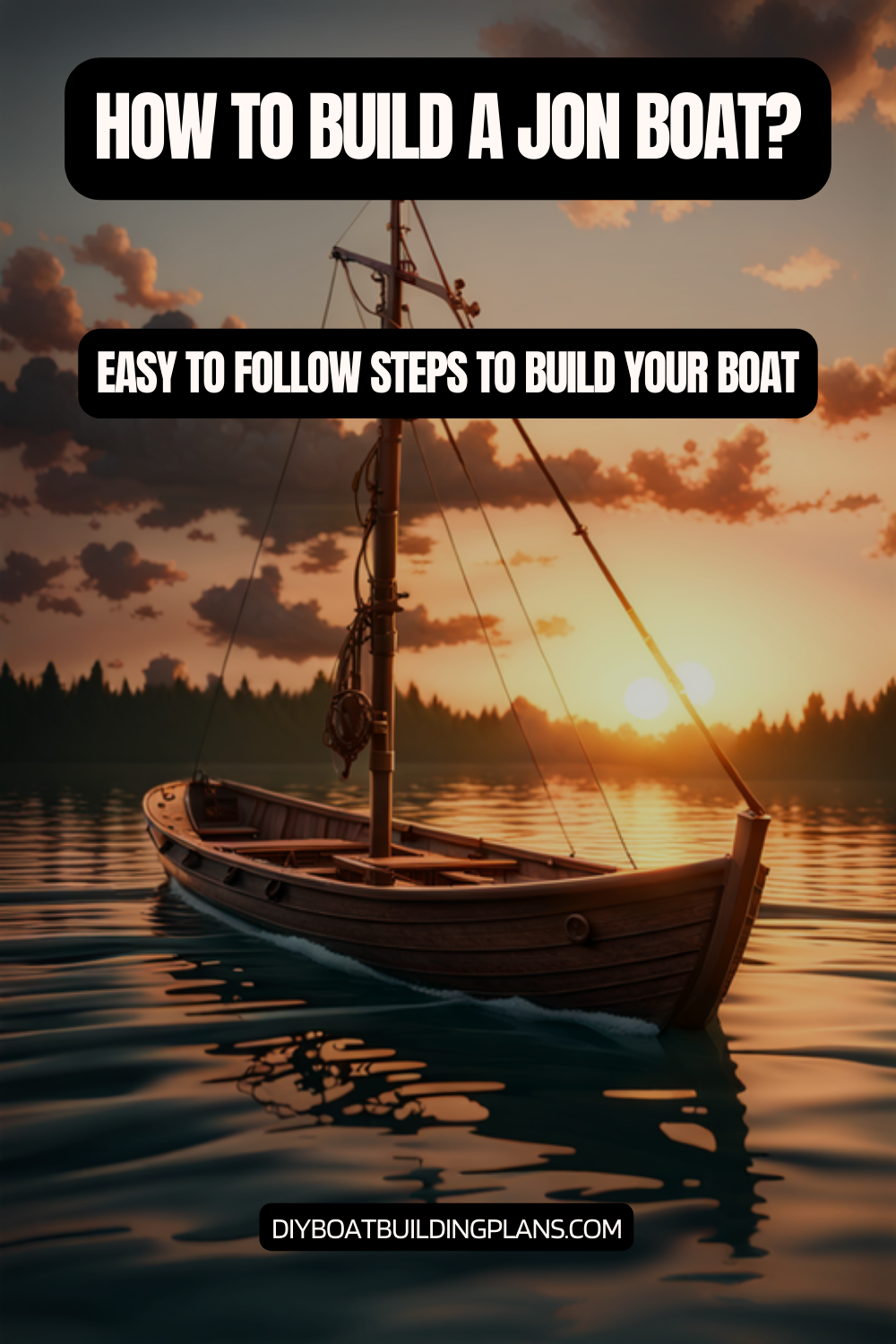Ever wondered if you could make your own boat without spending a lot? What if building a custom boat was easier than you thought?
DIY boatbuilding is more than a hobby—it’s an exciting journey. It turns weekend hobbyists into skilled boat makers. With homemade aluminum boats and simple designs, you can own a boat without the high cost of store-bought ones.
Building a jon boat at home needs passion, precision, and a desire to learn. Whether you love fishing or just enjoy the water, making your own boat is rewarding. It mixes skill with the thrill of the sea.
Key Takeaways – How To Build a Jon Boat
- DIY boatbuilding is accessible to motivated craftsmen
- Homemade boats can save significant money compared to commercial models
- Simple boat designs make construction manageable for beginners
- Building your own boat provides a sense of personal achievement
- Custom boats can be tailored to specific fishing or recreational needs

Understanding Jon Boats and Their Benefits
Jon boats are a special kind of watercraft loved by outdoor fans. They are great for fishing, hunting, and just having fun on the water. These boats are known for being reliable and easy to use.
Jon boats are simple yet very useful. They are light and easy to move around. Most are between 10 and 15 feet long. Their flat bottom makes them very stable in calm waters, perfect for rivers, ponds, and lakes.
Key Characteristics of Jon Boats
- Lightweight design weighing between 100-300 pounds
- Compact size suitable for one or two passengers
- Beam width ranging from 48-75 inches
- Easily transportable in pickup trucks or on roof racks
Advantages of Building Your Own Jon Boat
Building your own jon boat has many perks. It lets you customize it just the way you like. You’ll save money and feel proud of your creation. Plus, you’ll learn a lot about boat mechanics.
- Complete customization of design and features
- Significant cost savings compared to purchasing
- Personal satisfaction of creating a personalized watercraft
- Deep understanding of boat mechanics
“A jon boat is more than just a vessel—it’s a gateway to exploring hidden waterways and creating unforgettable memories.”
Jon boats are not just for fun. They are also great for fishing, hunting, and even utility work. Their shallow draft lets them go where other boats can’t, like swamps and mudflats. This makes them a must-have for adventurers and professionals.
Essential Materials Required
Starting a beginner boat project means picking the right materials. Knowing what to choose makes building your jon boat easier and more successful.
Types of Wood for Construction
Choosing the right wood is key for a strong boat. Marine-grade plywood is top choice for building a jon boat. Here are some wood types to consider:
- 1/4 inch B/C grade plywood (best for boat sides)
- Marine-treated lumber
- Exterior-grade plywood with waterproof coating
Fasteners and Hardware Essentials
| Material | Quantity | Purpose |
|---|---|---|
| Stainless Steel Screws | 1 lb (approx. 1/2 lb of 1″ coarse thread) | Structural connections |
| Waterproof Marine Adhesive | 1 tube | Sealing and bonding |
| Duct Tape | 1 roll | Temporary alignment and sealing |
Additional Necessary Tools
For choosing the best boat building materials, you’ll need these tools:
- Battery-powered drill
- Circular saw
- Jig saw
- Belt sander
- Clamps
“Proper materials make the difference between an average and an exceptional boat build.” – Experienced Boat Builder
Pro tip for beginner boat projects: Always invest in marine-grade materials to ensure longevity and water resistance.
Planning Your Jon Boat Design
Creating successful small boat plans needs careful thought. Jon boat construction starts with a design plan that meets your boating needs and practical limits.
When making your jon boat design, focus on key elements. The boat’s size and shape greatly affect its performance and use.
Choosing the Right Size and Shape
Choosing the right boat size involves knowing what you need. Think about these important points:
- Transportation limits
- The water you’ll use it in
- How many people and things you’ll carry
- What you’ll use it for (fishing, fun, etc.)
“The perfect jon boat design balances functionality with practical constraints.” – Boat Design Expert
Creating Detailed Blueprints
Creating detailed small boat plans needs precision and careful measurement. Your blueprint should have all the details:
| Design Element | Recommended Specification |
|---|---|
| Length | 12-20 feet |
| Bottom Width | 48-72 inches |
| Hull Material | Marine-grade plywood |
| Power Requirements | 20-55 horsepower |
Pro tip: Use digital design tools or drafting software to make precise jon boat construction blueprints. They should focus on structure and performance.
Good planning turns your jon boat idea into a reliable boat. Spend time on detailed design to make sure your build is a success.
Unlock the secrets to building your dream boat with MyBoatPlans! With detailed plans for over 518 boats and expert video tutorials, you’ll have everything you need to create your perfect vessel. Click here to begin your journey!
Gathering Tools for Construction
Building a DIY boat needs the right tools. You need precision and quality for accurate and durable work.
Choosing the right tools makes your boat project better. Good tools are a critical investment, say experienced builders.
Essential Hand Tools for Boat Building
- Measuring Tools
- Combination squares with imperial and metric measurements
- Precise compass for accurate layout
- Quality tape measures
- Cutting Tools
- Japanese crosscut saws (known for staying sharp longer)
- Sharp chisels for wood shaping
- Quality hand planes for smoothing edges
- Clamping Equipment
- Pipe clamps
- Spring clamps
- C-clamps in various sizes
Power Tools That Can Make Your Job Easier
| Power Tool | Purpose in Boat Building |
|---|---|
| Electric Drill | Creating precise holes and fastening |
| Circular Saw | Cutting plywood and lumber with precision |
| Jigsaw | Cutting curved parts in stitch and glue construction |
| Random Orbital Sander | Smooth finishing of surfaces |
“In tools, you get what you pay for” – A wisdom shared by experienced boat builders
Always put safety first. Wear safety glasses, ear protection, and a respirator mask when using power tools.
Safety Considerations While Building
Building your own jon boat requires careful attention to safety. DIY safety precautions can prevent injuries and ensure success. Knowing and using the right safety measures is key to protecting yourself.
Working with tools and materials demands focus on safety. Professional builders stress the need to protect yourself during the build.
Importance of Safety Gear
Having the right safety gear is vital. Always wear:
- Safety glasses or goggles to protect eyes from wood chips and debris
- Work gloves to prevent cuts and splinters
- Dust mask to filter out wood particles and chemical fumes
- Ear protection when using power tools
- Steel-toed boots for foot protection
“Safety doesn’t happen by accident. It requires intentional preparation and awareness.” – Boat Building Safety Manual
Handling Tools Safely
Boat building safety also means handling tools right. Here’s how to reduce risks:
- Keep work areas clean and organized
- Inspect tools before each use for damage
- Use tools only for their intended purpose
- Maintain sharp cutting tools
- Unplug power tools when not in use
Remember, a moment of carelessness can cause serious injury. By following safety practices, you’ll stay safe while building your jon boat.
Step-by-Step Construction Process
Making a homemade aluminum boat needs careful planning and precise steps. Jon boat construction involves many important steps. These steps turn raw materials into a working watercraft. Knowing the process helps DIY fans build their dream boat with confidence.
Building the Hull Framework
The hull framework is the core of your jon boat. Begin by setting up your workspace with the right tools and materials. Important parts for a successful build include:
- Sturdy wooden or aluminum supports
- Precise measuring tools
- Quality fasteners and connectors
- Waterproof adhesives
“A well-constructed hull determines the boat’s performance and durability.” – Experienced Boat Builder
Adding the Bottom and Sides
When adding the bottom and sides, precision is key. Follow these steps:
- Align transom with bottom panel
- Secure edges using stainless steel screws
- Apply waterproof marine-grade adhesive
- Install cross braces for structural integrity
The construction process needs attention to detail. Make the bottom plywood slightly larger, then trim it later. Use clamps to keep pieces in place during assembly.
| Construction Phase | Estimated Time | Difficulty Level |
|---|---|---|
| Hull Framework | 3-4 hours | Moderate |
| Bottom and Sides Installation | 2-3 hours | Challenging |
With careful execution, you’ll make a strong jon boat ready for water adventures.
Installing the Deck and Transom
Building a strong deck and transom is key in boat construction. They give your jon boat the strength it needs to perform well and last long.
Download over 500 Boat Plans. Click on the link below.
-->Click Here<--
When installing the deck, being precise is important. The deck acts as the boat’s main support, linking important parts together. It also gives you a solid base for your boating adventures.
Deck Installation Best Practices
- Ensure proper alignment with hull framework
- Use marine-grade sealants for waterproofing
- Support deck with robust internal bracing
- Check for uniform thickness and level surface
Creating a Sturdy Transom
The transom is a vital part of the boat. It’s best to use pressure-treated plywood for its strength. A well-made transom can handle the motor and water pressure well.
“A strong transom is the backbone of any reliable boat design” – Nautical Craftsman Magazine
| Transom Material | Thickness | Recommended Use |
|---|---|---|
| Pressure-Treated Plywood | 3/4″ – 1″ | Small to Medium Jon Boats |
| Marine-Grade Plywood | 1″ – 1.5″ | Larger Boats with Outboard Motors |
For simple designs, adding a false floor helps with stability. It also makes room for flotation foam. Proper sealant application and strategic reinforcement keep your jon boat dry and strong.
Finishing Touches
Finishing your DIY boat project needs a lot of care. The last steps turn your jon boat from a basic frame into a ready-to-use watercraft.
Sanding and Sealing Your Jon Boat
Getting to the final stage is all about precision. Experts say to follow a specific sanding order:
- Begin with coarse-grit sandpaper (60-80 grit)
- Move to medium-grit sandpaper (120-150 grit)
- End with fine-grit sandpaper (220-320 grit)
For sealing, pick a marine-grade urethane sealant. We used about 600ml of urethane glue for strong water protection.
Painting and Protective Coating
Your boat’s outside needs strong protection. Use exterior acrylic marine paint for both durability and looks.
| Paint Type | Coverage | Recommended Use |
|---|---|---|
| Marine Acrylic | Excellent Water Resistance | Exterior Boat Surfaces |
| Epoxy-Based Paint | Superior Durability | High-Wear Areas |
“A well-finished boat shows the builder’s skill and detail.” – Master Boat Builder
Adding Essential Accessories
Make your boat better with key accessories:
- Rod holders for fishing
- Storage spots
- Non-slip deck
- Mounts for extra gear
Use hot-dipped galvanized fasteners for accessories. This matches the 748 screws we used.
Maintenance Tips for Your Jon Boat
Keeping your jon boat in top shape needs regular care. Proper maintenance extends your boat’s life and makes water trips safer and more fun. Whether you fish on weekends or just enjoy boating, knowing how to maintain your jon boat is key.
Good maintenance starts with regular checks and taking action early. Experts say to create a detailed maintenance plan. This plan should cover important parts of your boat.
Essential Maintenance Practices
- Wash your boat with fresh water after each saltwater use to prevent galvanic corrosion
- Clean the exterior using mild boat soap or a water and vinegar mixture
- Inspect the hull for possible damage or wear after each use
- Check and tighten all fasteners and rivets regularly
Protecting Against Corrosion
Aluminum boats need extra care to avoid corrosion. Captain Phab Aluminum Hull Cleaner is great for keeping aluminum parts shiny and safe. Don’t forget to watch out for fuel tank leaks, often caused by corrosion.
“Regular maintenance is the key to preserving your jon boat’s performance and longevity.” – Marine Maintenance Experts
Fuel Tank and Structural Maintenance
- Apply protective paint to fuel tanks
- Use stainless steel washers in fittings
- Ensure proper air circulation around the tank
- Use neoprene or Teflon for support systems
By following these tips, you’ll make your boat last longer and run better on the water.

Launching and Enjoying Your Jon Boat
Your handcrafted flat bottom jon boat is more than a watercraft. It shows your skill and love for boating. Before you launch, check every seal and make sure everything is tight.
Start in shallow, calm waters for your first launch. This helps you see how stable the boat is and if there are leaks. Always wear a life jacket and carry safety items like a whistle, flashlight, and first aid kit. Electric motors are great for your jon boat because they’re easy to maintain and good for the environment.
Preparing for the First Launch
Know your boat’s weight limit and the best water conditions. A flat bottom jon boat is best for calm lakes, slow rivers, and safe coastal spots. Stay away from rough waters to keep your boat and you safe. Your boat is made for specific places, so know its limits.
Safety Tips While On Water
Always check local boating rules and the weather before you go. Keep your phone charged, tell someone where you’re going, and have emergency supplies. With the right prep and care for your jon boat, you’ll have many fun times on the water.
FAQ – How To Build a Jon Boat
What materials do I need to build a jon boat at home?
You’ll need ¼ inch oak plywood for the sides. Also, 1×2 or 1×4 stock for log chines. Use waterproof glue and stainless steel screws for assembly.
Don’t forget marine sealant, floatation foam, and shelf brackets. You’ll need clamps, handsaws, power drills, and circular saws for tools.
How long does a typical DIY jon boat take to build?
Building time varies based on your skill and time. Beginners might spend 20-40 hours over weeks. The right tools and a clear plan can speed up the process.
What is the recommended boat size for a beginner?
A 7½ feet long jon boat is perfect for beginners. It’s easy to handle, fits in most trucks, and is simple to build.
Can I build a jon boat if I have limited woodworking experience?
Yes! Jon boats are great for beginners. With patience and a clear plan, even those new to woodworking can build a functional boat.
What safety gear should I use while building my jon boat?
Wear safety goggles, work gloves, a dust mask, and ear protection. Always work in a well-ventilated area. Keep your space clean and organized.
How much will it cost to build a DIY jon boat?
Costs range from $300 to $800, based on materials and size. Building your own can save money compared to buying a pre-made boat.
What type of water is a jon boat best suited for?
Jon boats are best for calm waters like lakes and slow rivers. They’re great for fishing and other activities in smooth water.
How do I waterproof my homemade jon boat?
Apply marine-grade sealant to all joints. Use multiple coats of marine-grade paint, focusing on seams. Consider epoxy resin for extra protection.
Can I add a motor to my DIY jon boat?
Yes, but make sure your transom can handle the motor. Most jon boats can support up to 25 horsepower, depending on size and build.
How often should I maintain my homemade jon boat?
Check for leaks and inspect the hull and transom after each use. Touch up paint or sealant as needed. Clean the boat well. Annual maintenance is key for longevity.



